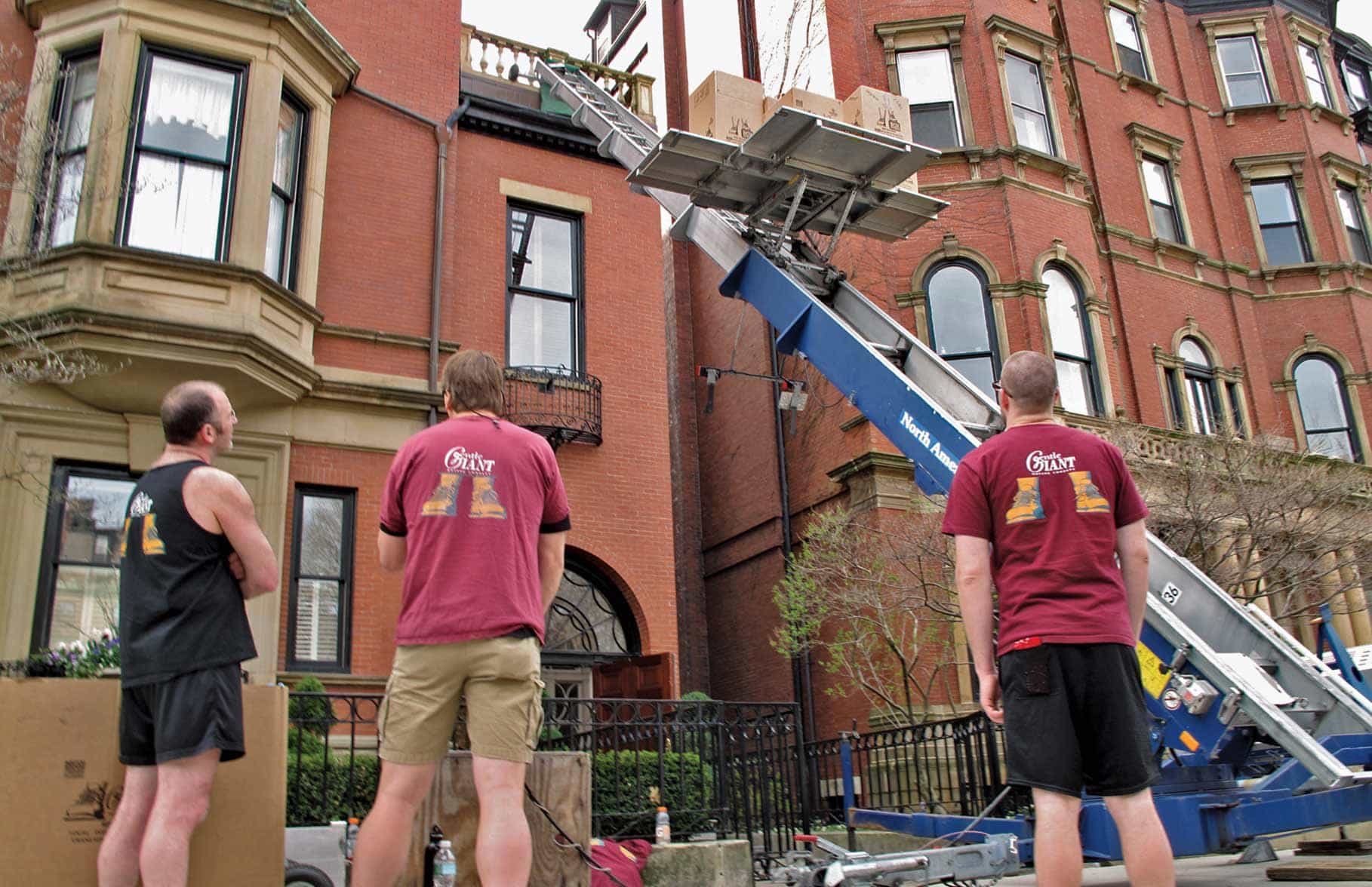
Editor’s Note: Gentle Giant training expert Noah Duarte was recently interviewed by The Bamberger Group, a leading real estate brokerage in the Murray Hill neighborhood of Manhattan. They discussed the unique technical challenges that professional movers confront in New York City, and how Gentle Giant utilizes cutting-edge technology, sophisticated training, and strong relationships with their customers to get the job done effectively. The original article can be found on their blog, Bamberger Answers.

The Bamberger Group: What kind of moves require the use of cranes? What is the process of using cranes in a residential move, from planning to execution?
Noah Duarte: I ran our New York moving office for about five years, and before that I was in Boston. Now, I’m back in Boston. From a craning standpoint, it’s very different from New York than it is in Boston. In Boston, we have our own cranes, [and] we have our crane operators, who are all licensed operators for that type of machinery. And it really is as simple as getting a permit for the parking spot for the crane, and then getting a police detail to direct traffic when we’re operating the crane.
In New York [City], it was a much different experience. We didn’t have the equipment in New York, so we would contract through another company, and there were a couple different companies where we would contact if we needed a crane for a specialty job. And the difference is that in New York, it would involve shutting down one whole side of the street, or shutting down the entire street– which, from a cost perspective, puts the price sky-high. For instance, we were going to be craning a piano, and [blocking off the street] put the labor– which might have been a few hundred dollars to move the piano– adding the crane to it, took many thousands of dollars to do that.
So New York is a very tricky place to move. And the things I grew very accustomed to in Boston, we just didn’t have in New York. Parking permits, for instance, were not a thing; you could not get parking permits. So it was really catch as catch can for parking any type of moving vehicle down there. The biggest difference, from a craning standpoint, is costs, logistics, coordinating with the city, and making sure that safety is observed at all times for all pedestrians.
TBG: Are there specific kinds of insurance that come into play when working with cranes?
ND: [It depends] on the company you use. In Boston, our insurance carrier, our policy covers us for the different services we offer. But if you are contracting with a crane company, that would be something that they would have [with] their carrier, that you would want to check with them to make sure they carry that necessary coverage. It kind of depends on the company that you’re dealing with, and the locale that you’re in. So for instance, Manhattan vs. Westchester County– there would be changes between [different locales] in the State of New York.
TBG: Does your New York office have strong relationships with local crane companies that you regularly use?
ND: There were a couple crane companies that we had contacted when we did need those services, and to be quite honest with you, the number of times that we needed to contract out through a crane company were probably one or two times in a five-year span that I was down there. So the call for craning, for what we typically do within the moving services [we offer], didn’t require us to contract with a craning company very frequently.
TBG: How frequently do you deal with antiques or other specialty items? How often did you involve moving methods and technologies that went beyond the usual packing and moving process?
ND: On a daily basis we deal with antiques or types of furniture that, if you weren’t being conscious or aware of what you’re doing, you were going to damage it. But here’s the interesting thing about moving that I think a lot of people– a lot of customers, a lot of companies– lose sight of: the furniture itself is fairly straightforward. If you have a good head on your shoulders, if you’re paying attention to what you’re doing, if you’re leading the furniture through your hands and through general observations… most people can handle or pick something up without doing damage to it. The real challenge within the moving industry, and the thing that a lot of companies aren’t very good at, or lack– and I wouldn’t even say that they’re not good at it, they just don’t recognize it, so they don’t focus on it– is the fact that the furniture doesn’t change, but the customer does. The customer is a dynamic entity or being, if you will, within the whole move itself. So from an object standpoint, the furniture isn’t a big deal. There’s training that we provide– there’s training both in the field, and in conference– that you go through manuals, tutorials, lecturing, and coaching on how to deal with different pieces of furniture. But the customer changes. [Maybe] the closing starts to get a little shaky. Or they got a phone call from a neighbor or from a relative with either good news or bad news. Maybe they’re downsizing, maybe a life change is coming, and they need to go someplace that they weren’t anticipating. And emotionally, they start to change. And from a moving standpoint, if the crew aren’t aware of that– if they’re not paying attention to that, if they aren’t catering to that– then you could be moving pieces of cement. You know, we could be moving logs. And if you’re not paying attention to the customer’s needs, then their [items] aren’t really the important thing. In terms of technology, we’re constantly looking to where we could add a technological edge, but when it comes to moving things, we’re not at the point where we can pre-program something. It’s still a hands-on, concerted event for us.
TBG: What is a Bocker furniture elevator, and when do you use it?
ND: This is basically a self-contained elevator. It has an arm that extends up to higher floors– I think our elevator goes up to a fifth floor– and this arm that extends up, much like a crane boom, but the difference being that with a crane, you have the cables that lift things up to the boom, [whereas] this actually has a basket that starts at the ground level. We can load [the basket] from the lift gate or from the back of our truck, and then that platform travels up to the window where the furniture is brought in. So if you have a spiral staircase, or difficult access– meaning really narrow stairways or really low overhang on stairways– then a furniture elevator is a good alternative. It can actually speed up the move; it keeps things moving right along.
TBG: How do you decide when the use of specialized equipment will be necessary? Does the customer request these items in advance, or do you have someone who comes to a home to assess the move and advise the customer on what will be required to get the job done?
ND: The customer definitely plays a part in advising us about previous moving experiences they’ve had in this situation. So if we’re going out to a move and the customer alerts us to the fact that a sofa had to be craned into the third floor, or a piano had to be craned in, and maybe we were [planning on] hand-hoisting something, bringing something in from off the porch… that’s something that it’s good to give us a heads up [about]. But we do have outsiders [to the moving process], and there are a number of us that come in at the first inclination that something might not be quite right, or a little suspect. And we’ll go out to a residence to take a look at what we would be walking into, just to make sure that, first and foremost, our crews are safe– that the people we’re sending out there are going to be well connected and well-informed as to what’s going to be required. Secondly, we want to make sure that we’re not running the risk of damaging any property. And third, so that we can create that face-to-face, and that open communication with the customers as to what they should be expecting and what we can deliver on.
TBG: Finally, how do you handle private art installation, sound systems, or home theaters? Where do you draw the line of service for dismantling and setting up these items?
ND: We principally draw the line at hanging artwork or hanging TVs– so, reinstalling the brackets or the actual hardware to set up the artwork. And that’s from an insurance standpoint. We do have a separate division in the company that will come in and install your TV and install artwork as well. So from a moving standpoint, as a moving company, we don’t want to have our people hanging artwork. Within the umbrella of our company, we do have a division that will go out and do that. But that would be a separate service that we offer.
Special thanks to Aaron at The Bamberger Group for reaching out to us for this interview! To learn more about our craning services, please click here. To learn more about our New York office, click here.

